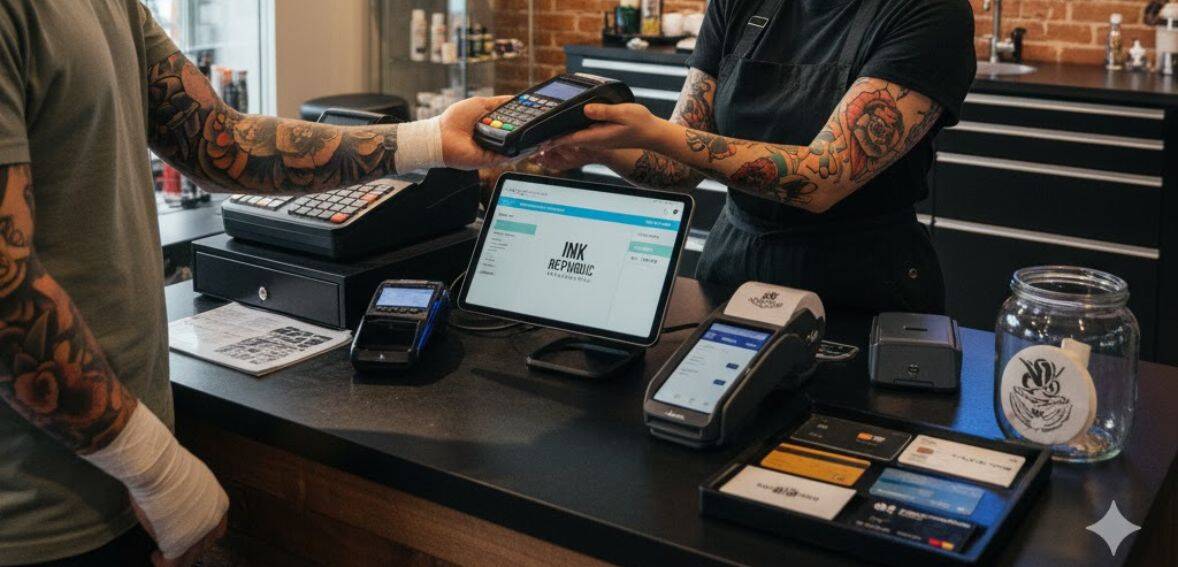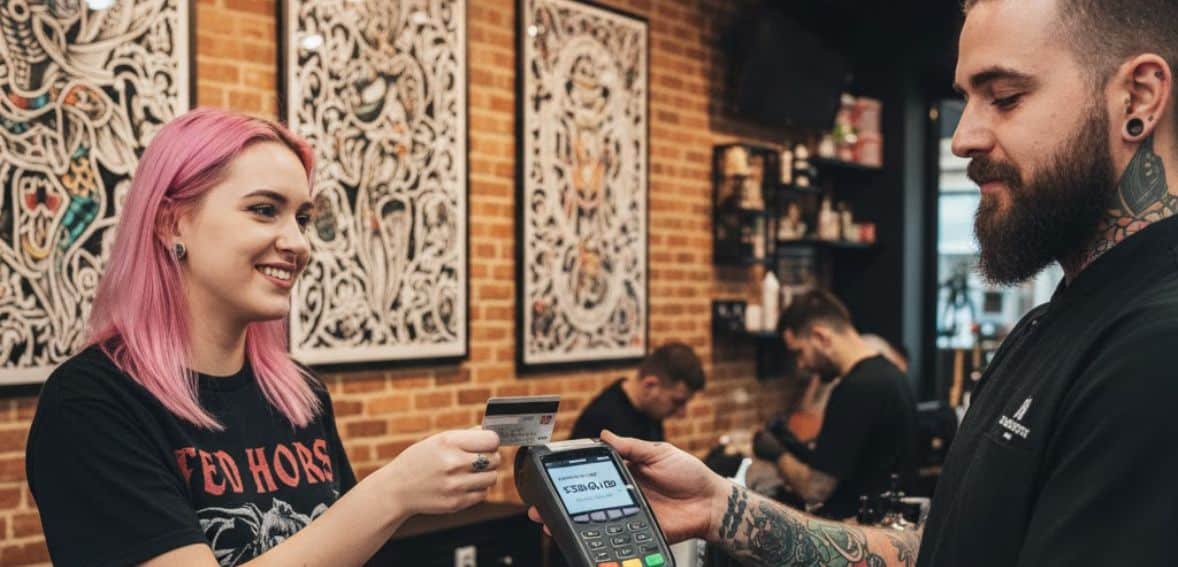
By alphacardprocess October 27, 2025
Merchant services tend to consider tattoo studios high-risk. The term doesn’t always indicate the business’s trustworthiness but is a consideration of industry-wide reservations such as high rates of chargebacks, reputational risk, and stringent regulatory attention.
These issues can complicate tattoo studios access to conventional payment processing facilities, and this is usually reflected in high fees, rolling reserves, and more demanding approval terms. Knowing why this categorization exists can assist tattoo shop owners in identifying the proper high-risk merchant account provider and taking steps to minimize financial friction.
What Is a High-Risk Merchant Account?

A high-risk merchant account is a payment processing account type for businesses that are deemed more prone to chargebacks, fraud, and regulatory problems. As a result of the risk perceived, processors tend to have higher fees, roll reserves, and stricter approval procedures.
Despite all these difficulties, a high-risk merchant account enables companies to process credit and debit card payments securely. Dealing with specialized experts assists high-risk companies in managing risks, remaining compliant, and enjoying consistent cash flow while establishing trust with processors over time.
Why Is Tattoo Studios Considered High-Risk?

Tattoo companies are usually considered”high-risk” by financial institutes and it is not always justified. In spite of the increased popularity and mainstream acceptance of tattoos, some old prejudices still persist.
Certain payment processors are concerned correctly or incorrectly that tattoo shop customers will use stolen credit cards or are more likely to be engaged in fraud. This perception, fact or not, causes banks and processors to be hesitant. Tattoo businesses, as a result, tend to have increased fees, more paperwork, and more rules when attempting to obtain financial services.
There’s also the residual stigma that tattoo parlors are shady or cater to questionable crowds. Though this outdated perception doesn’t hold with the modern reality where tattooing is considered as an art form and a legal career—it still taints how banks view the business.
It’s ultimately these reputation-driven worries that drive tattoo shops into the high-risk category, making it more difficult (and costly) for them to obtain the assistance they require to operate their businesses.
How Does Being a High-Risk Business Affect a Tattoo Shop?

If you’re a tattoo business owner, you may not know how much it can impact your business to be considered a “high-risk” company, particularly when it comes to processing payments. Most tattoo businesses remain cash- or check-only just because utilizing traditional payment processors is costly and cumbersome.
Here’s how being high-risk hurts your bottom line:
1. Increased Transaction Fees
Tattoo businesses tend to pay a higher amount per credit or debit card transaction than lower-risk enterprises. Whereas most companies are charged 1.5% to 2% per transaction, tattoo businesses may be charged twice then that.
2. More Expensive Flat Fees
Aside from the percentage fees, there also comes a flat fee per transaction. For high-risk ventures such as tattoo studios, even the flat fees will be higher.
3. Huge Rolling Reserves
Payment processors often require a “rolling reserve,” which is essentially money held back from your payouts to cover potential chargebacks or refunds. For high-risk businesses, this reserve can be significant—tying up your cash and making it harder to manage day-to-day operations.
4. More Paperwork and Delays
Looking to begin accepting card payments in a hurry? Slow down. High-risk companies are usually subject to tougher demands and more legal procedures. You might be required to submit your personal credit history, several months of bank statements, and extensive business paperwork. It can be time-consuming to gather all this information, particularly for newer stores.
Due to such difficulties, most tattoo stores are forced to work with specialized high-risk merchant account providers or firms that know the distinct requirements of businesses. These providers specialize in assisting high-risk customers through the process, usually with improved support and conditions than large, generic processors.
What Can Tattoo Shop Owners Do to Reduce High-Risk Status?

While it’s difficult for tattoo parlors to entirely lose the “high-risk” designation, there are smart moves that owners can make in an effort to reduce their risk profile and save money. It benefits you by allowing you to gain access to better financial services, as well as happy, repeat customers.
The solution is to concentrate on diminishing fraud, enhancing customer service, and dealing with a merchant account provider that has experience with the tattoo industry. These providers deal with high-risk companies and can assist you with customized strategies to reduce risk and cut costs. Some effective methods to diminish risk are:
1. Enhance your Payment Security
Using old payment systems renders your shop increasingly susceptible to fraud. Ensure that you are using the most current POS (point-of-sale) technology and payment security mechanisms. Adequate encryption, tokenization, and PCI-compliant platforms can do wonders to secure your business and customers. You can have the best options ensured by a good merchant provider.
2. Keep Chargebacks Low
Chargebacks harm your reputation with processors and incur fees. Cooperate with your provider to examine past chargebacks and put into place measures to avoid them. This may involve improved documentation, enhanced communication, or detailed policies regarding deposits and cancellations.
3. Be Open with Customers
Clarity fosters trust. Keep your customers’ needs simple: be transparent about your prices, what they’re paying for, and your return and refund policies. When expectations are set, miscommunication and disputes are less likely to occur.
4. Provide Excellent Customer Service
Dissatisfied customers are much more likely to dispute a charge or seek a chargeback. Courteous, helpful service will prompt them to contact you with questions rather than immediately contacting their bank.
5. Partner with the Right Provider
Not all merchant account providers are the same. Tattoo shops work best with providers who understand high-risk businesses and provide tailored solutions. A specialist will assist you in being compliant, minimizing your risk, and being able to access lower-cost payment processing.
Taking these proactive measures won’t remove all risk, but they’ll demonstrate to payment processors that you operate a secure, reliable business, and that can eventually enhance your rates and alternatives.
How to Select the Right High-Risk Merchant Account Provider

For high-risk companies, finding the proper merchant account provider isn’t simply about payment processing—it’s about protecting your operation, enhancing financial health, and facilitating growth. Here is an in-depth analysis of what to look for when assessing providers:
1. Industry Expertise
Not all providers understand the problems of high-risk industries. Always choose a provider that has hands-on experience with businesses like yours. Industry-specific knowledge allows them to offer tailored solutions, navigate regulatory challenges, and create risk mitigation strategies that suit your business model.
2. Transparent Pricing
High-risk merchant accounts typically have higher fees because they have more exposure to fraud and chargebacks. Your reliable provider should provide clear disclosure of the charges. These include setup, maintenance charges, per-transaction, rolling reserves, and any other charges. Don’t use providers that hide their fees in the fine print—transparency at the beginning saves you unexpected surprises later.
3. Flexible Contract Terms
Most high-risk providers demand long-term commitments, but that shouldn’t mean you have to put go through it. Find providers with month-to-month arrangements or short initial contracts with the potential for renegotiation as your business expands or your risk profile changes. Easy cancellation terms and upgrade flexibility can facilitate a change in providers or expansion without huge penalties.
4. Tested Track Record
A provider’s record is a good indicator. Seek third-party testimonials, client feedback, and industry-specific case studies. Be cautious of providers with ongoing negative feedback or unresolved complaints. Your ideal provider would be known for both ethical business conduct as well as for being capable to serve high-risk businesses during growth and setbacks.
5. Robust Security Features
Fraud and chargebacks can cripple a high-risk business. Your provider should offer robust security infrastructure—such as tokenization, encryption, 3D Secure authentication, PCI compliance, and advanced fraud detection tools. These features protect your business from data breaches and reduce the likelihood of chargebacks, helping you maintain a strong processing reputation.
6. Reliable Customer Support
When something goes wrong with payment, taking action on the right time is the top priority. Your merchant provider should provide reliable, 24/7 customer service by phone, email, and live chat. Seek out dedicated account managers or high-touch service platforms where you get a single contact who knows your business. Quick, knowledgeable support can make the difference between an small issue and a high impact consequences on your business.
7. Payment Gateway Compatibility
Make sure the payment gateway of your provider seamlessly integrates with your existing systems, whether that’s an online booking tool, eCommerce website, or mobile POS. Integration with your CMS, CRM, and accounting software will minimize technical headaches and simplify operations.
8. International Transaction Support
If you have international customers or intend to go global, your provider must be able to handle transactions in several currencies, accommodate local payment options, and comply with foreign laws. Tools for currency conversion, support in multiple languages, and cross-border compliance are critical features in global business.
9. Risk Management Tools
Your processor needs to do more than process payments, they need to actively assist you with mitigating and minimizing risk. Search for features such as chargeback notifications, real-time fraud detection, transaction scoring, and customized analytics dashboards. Certain processors even provide educational materials or consulting services to ensure compliance and eliminate unnecessary chargebacks.
10. Read the Agreement Thoroughly
Prior to signing on the agreement, review all the terms and conditions with utmost attention. Pay special attention to pricing tiers, termination clauses, requirements for rolling reserve, hardware or software commitments, and minimum volume requirements. If things don’t make sense, don’t be afraid to get clarification. A reasonable and well-written agreement is critical to long-term stability.
Conclusion
Though being categorized as a high-risk business can pose difficulties for tattoo shops—i.e., increased fees, tougher regulations, and reduced access to conventional payment processors, it doesn’t necessarily have to stifle your business.
Knowing the cause high-risk tag and selecting a provider that has experience working in tattoo parlors, you can find stable, secure, and affordable payment solutions. With proper support and proactive risk management practices, tattoo business owners can still expand their business while having secure, consumer-friendly payment processes.